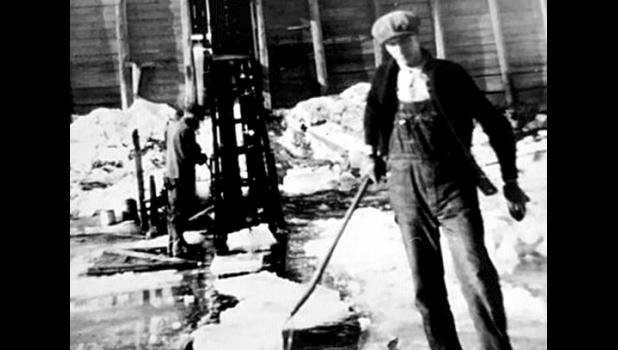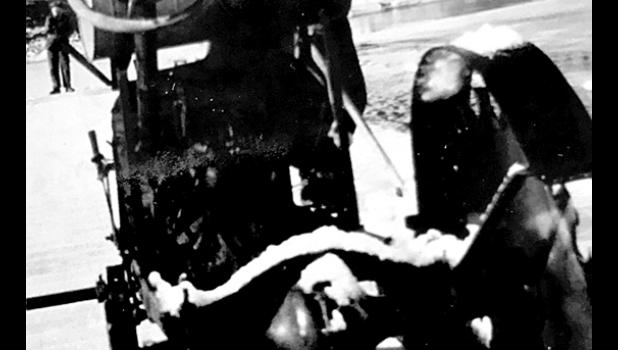Iceman cometh, iceman goeth

The words "Don't be like me" have always resonated with Minneota native Sharon Locy.
"That's what my grandfather, Honore Locy, used to say to me," she explained. "He would tell me to be smart and go to school, and to not be like him.”
"My grandfather was an ice harvester and he would say, 'I'm a man who built his house on ice'. It was his whole life and (his career) eventually became obsolete when he was in his 70s. I always felt kind of sorry for him."
Because she admired her grandfather and the hard work he did, she recently completed and had published a book that was a fictionalized version of his life called, "The Ice Harvest".
The book focuses on one year (1952-53) of what goes into ice harvesting, including preparation in the fall and taking down the equipment following ice harvest season. That was also the final year Honore harvested ice.
"I wanted to honor my grandfather, who was a Belgian immigrant," she noted.
"He worked hard and cared about the work he did." Honore Locy died in 1964.
"He was always very careful to make sure the pond he got his ice from was clean.” “He would even send samples of the water he would get his ice from to the Cities to be tested. He wanted the water to be clean so the ice would be clear."
In her book, Locy refers to the year 1952 when the New York Yankees and Los Angeles Dodgers are playing in the World Series, the Korean War is ongoing, Dwight D. Eisenhower is about to be sworn in as the 34th President of the United States … and her character Henry Loos is preparing to harvest his ice for the last time. Honore Locy is the only "real" character in the book, although Sharon adjusts his name slightly to Henry Loos.
"The book centers around three characters; Henry, his son Ed who is stuck in his same job, and his pre-teenage granddaughter Margaret," said Locy.
"It focuses on the psychology of these three characters.” Those three characters are trying to figure out their life while living in a small town. “Although Henry is a fictionalized version of my grandfather, the son and granddaughter are not based on my father or me."
Sharon Locy grew up in Minneota. Her late father Julius E. Locy, who died in 1999, was a well-known photographer and school bus driver in Minneota. He also worked part-time for Mascot Publisher and Editor Ragnar Guttormsson as a typesetter and ad salesman.
Sharon's mother was killed in a car accident when she was only eight years old. Her grandparents and parents are buried in a family plot in St. Edward's Cemetery in Minneota. "I was born at Dr. Sanderson's hospital, which was basically his home," Locy noted. "My family moved to Marshall when I was an early teen. But I will always remember my time spent in Minneota." Locy received a B.A. in English at the now closed College of St. Teresa in Winona, MN, and a Ph.D. in English (19th Century British Literature) at the University of California, Davis. She went on to teach literature and writing at Loyola Marymount University in Los Angeles for 35 years.
Now retired, “The Ice Harvest” is Locy's first novel. "I had the idea a long time ago to write the book," said Locy, who now resides in Santa Monica, CA.
"I had been working on this book for several years.” "I feel a little like Grandma Moses (Anna Mary Robertson ‘Grandma Moses’ is often cited as an example of an individual who successfully began a career at an advanced age). I'm a retired teacher in my late 70s, nearing the end of my life and now I'm having this book come out. I'm just happy it's been published in my lifetime." The book begins in the fall of 1952 when the preparation for the upcoming ice making season begins. "Ice harvesting is just the opposite of farming," Locy said.
"When farmers are ending their harvest season, ice harvesters are just beginning their season."
Some of the business names in the book will be familiar to many locals, including The Big Store, Minnie's Coffee Shop, The Roundup Saloon (not in the same location as the current Roundup) in Minneota, and St. Eloi Church in Ghent. The fictitious city Locy named as the centerpiece for her book is Grandview after the Lyon County Township by the same name. And the ice being harvested in the book comes from the Yellow Medicine River, one of the same places her grandfather harvested his ice.
"Grandview is actually a composite of Minneota, Ghent and Marshall," she explained.
"And many names in the book, although they don't represent 'real' people, are familiar local names of Belgians, Icelanders and others. Any resemblance is purely coincidental."
Harvesting ice was not only dangerous, but extremely hard work that was performed in all kinds of adverse weather. In days prior to modern refrigeration, ice harvesters were vital to assist in the preservation of perishable food by both businesses and residents. In order to make the blocks of ice to be sold, a harvester would first search for an area on a lake, pond or river where they feel will make clear and solid blocks of ice.
Locy tells of the process of making an ice block from start to finish in Chapter Nine of her book.
"He marked the lines for the first cuts in both directions, estimating how much of the pond he would use. He pulled the starter cord (of the ice-cutting machine) a third time. The engine started, the circular saw blade turning slowly, then faster, sinking into the ice.”
"The blade was calibrated to cut down 16 inches into the ice, leaving two inches at the bottom to be cut through with the ice saw or tapped apart with the bar.”
"They would move one row of ice out first, making a channel to the middle of the pond. Working from the inside out, they would push the ice up the channel to the elevator, moving out to the edge from the center.”
"The trucks were full, packed with cakes edge to edge, three rows high. Four tons, that was a truckload. Henry realized, as he revved up the truck's motor, that his feet were icy cold."
The book brings you to a time of yesteryear, when work was hard and the hours were long. As technology was advancing, icemen like Henry were becoming obsolete. This is a story of how Henry, his son and granddaughter cope in an ever-changing world. "We often define ourselves by the work we do," Locy said.
"Just as my father defined himself by the work he did and I define myself by the work I did, my grandfather defined himself by being an iceman for over 40 years."
The book is dedicated to her grandfather and father; the iceman and his son. Ice Harvest is 144 pages and is available for order online at www.tsehaipublishers.com for $14.95, plus $6.50 shipping.



